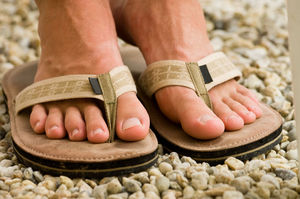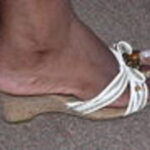Wander through the personal care aisle of any grocery store or the shelves of your local day-spa and you will find many rows of creams, lotions, oils and scrubs all singing praises of curing feet of the dry calluses and cracked skin that plague millions of people every day. Any number of these “miracle” cures will work to an extent, and may even relieve you of the bulk of your symptoms when used consistently over a long period of time.
But what causes the issue of dry feet to begin with? And what keeps the symptoms coming back when you stop applying treatment? Although I am not a medical professional, I have suffered from dry feet for all of my adult life and here are some of the things I have found to be common causes of dry, itchy cracked and callused feet.
Shoes
If you have calluses, dry heels or patches of dry skin, your shoes may be to blame. Shoes that fit either too loosely or too tightly can cause problems for the skin on your feet, not to mention the potential for contributing to a host of back, hip and joint problems. Even if you’re sure that you always wear a size 7, don’t just grab a pair shoes and head to the checkout stand. Take the time to talk to a sales person and have them measure your feet and match you to shoes that fit perfectly since most shoe manufacturers do not use standard sizing charts. You may find that while you are a size 7 in one brand, you may be a 7.5 or even an 8 in other brands.
Socks / Nylons
If you are suffering from cracked skin that is peeling or red in patches, you may need to change the type of sock that you are wearing. Although pretty and more professional, stockings and nylons may cause symptoms of dry feet to worsen. The nylon fibers may further irritate broken skin, and the dyes in stockings and colored socks may provide an additional irritant. Try switching to plain white cotton or natural colored bamboo socks since they will allow your feet to breathe and are void of chemical dyes. The fluffy cotton or bamboo fibers will also help protect your feet if you are using foot creams better than a synthetic fiber would.
Scaly, itchy and flaky skin between the toes may be symptoms of Athlete’s foot. Athlete’s foot is caused by a common fungus that is easily picked up by walking barefoot in moist areas such as community showers, paths beside swimming pools and locker rooms. If you suspect athletes foot, don’t despair, there are many over-the-counter creams that can be used to kill the fungus and allow your skin to heal. Make sure that in addition to applying the cream to your feet that you also purchase a powder or spray to treat the fungus in your shoes to prevent re-occurrence, and keep other skin care lotions and creams away from affected areas as their moisturizers may cause the fungus to spread.
Detergents
If you have tried everything you can think of, and nothing seems to help, the culprit may be your laundry detergent. Many detergents have dyes and cleaning agents that can quickly and severely irritate sensitive skin, worsening dryness or causing an itchy rash. An easy test is to purchase a small bottle of detergent that is labeled as having no dyes, perfumes, enzymes or preservatives (I recommend Free Clear by ALL) and wash 2 week’s worth of socks with it. Wear only the socks washed in the sample detergent and by the end of the second week, you should see relief if your detergent is indeed your problem.
Age
Unfortunately, as you age your skin will continually change. The older skin gets the less supple and reactive it is to changing temperatures, environments and activities. It is important to treat your feet as well as you treat the rest of your skin. Adding foot-hygiene to your daily skin care regiment is essential in making sure that symptoms of dry feet do not continue to worsen with age.
Other Medical Conditions
Excessively dry skin, an itchy rash, cracks or redness along the pads or heels of your feet may also be symptoms of another, more serious medical condition. Rapid weight gain may cause you to stand differently than you normally do, putting increased pressure on the heels or pads of your feet. Diabetes or thyroid gland issues may cause feet to swell, cause changes in your sweat patterns or create changes to your metabolism that your skin is unable to keep up with. If you have ongoing issues with dry feet, check with your doctor to see if another medical reason is the cause.
Once you are able to discover what is causing your dry skin, it will be much easier for you to manage the symptoms and alleviate the pain and irritation that having dry feet brings. Take care of your feet, and they will continue to take care of you!
For more information on the causes, symptoms and treatment of dry feet, click below:
Footcare.ygoy.com
En.allexperts.com
www.footsmart.com



